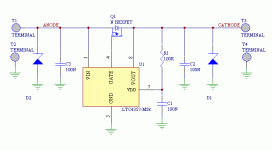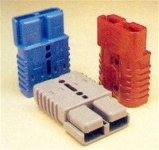Tiberius
10 kW
Hi All,
A couple of times we have discussed Ideal Diodes on here. Eg: http://endless-sphere.com/forums/viewtopic.php?f=14&t=4607&p=84876&hilit=Ideal+Diodes#p84876
An ideal diode is one that does not have a forward voltage drop and therefore doesn't get hot and waste power when carrying a high current. For instance, we commonly recommend people use Schottky diodes when combining battery packs in parallel, but a Schottky will have 0.5 to 1 V forward drop at high current, so at anything above a few amps it needs a heat sink.
Anyway, I just built some:

This is a little surface mount board with a FET with a control circuit. When the voltages are the right way round the FET turns on. Otherwise the FET is off.
I've set it up so the connections can be made by various ways, such as soldering, or by bolting on terminals

The spacing is also right for Anderson PP's


They can also be bolted together in stacks for various functions. Here is an assembly I used to combine 3 36 V battery packs to run a bike. There are two output cables, one for the controller and one for auxiliaries.

These are designed to operate up to 80 V. I've put 100 V surge suppressors on each end in case of inrush sparks when connecting and disconnecting. They've been used in anger on one of my bikes and survived. So far I've only tested them in the lab up to 20 A, but at 20 A they don't need heatsinks.
Anyway, guys, I'd be interested in your views/comments, etc. As I said, I'm still testing them, but they're looking good so far and I may tweak the design and make another batch.
Nick
A couple of times we have discussed Ideal Diodes on here. Eg: http://endless-sphere.com/forums/viewtopic.php?f=14&t=4607&p=84876&hilit=Ideal+Diodes#p84876
An ideal diode is one that does not have a forward voltage drop and therefore doesn't get hot and waste power when carrying a high current. For instance, we commonly recommend people use Schottky diodes when combining battery packs in parallel, but a Schottky will have 0.5 to 1 V forward drop at high current, so at anything above a few amps it needs a heat sink.
Anyway, I just built some:

This is a little surface mount board with a FET with a control circuit. When the voltages are the right way round the FET turns on. Otherwise the FET is off.
I've set it up so the connections can be made by various ways, such as soldering, or by bolting on terminals

The spacing is also right for Anderson PP's


They can also be bolted together in stacks for various functions. Here is an assembly I used to combine 3 36 V battery packs to run a bike. There are two output cables, one for the controller and one for auxiliaries.

These are designed to operate up to 80 V. I've put 100 V surge suppressors on each end in case of inrush sparks when connecting and disconnecting. They've been used in anger on one of my bikes and survived. So far I've only tested them in the lab up to 20 A, but at 20 A they don't need heatsinks.
Anyway, guys, I'd be interested in your views/comments, etc. As I said, I'm still testing them, but they're looking good so far and I may tweak the design and make another batch.
Nick



